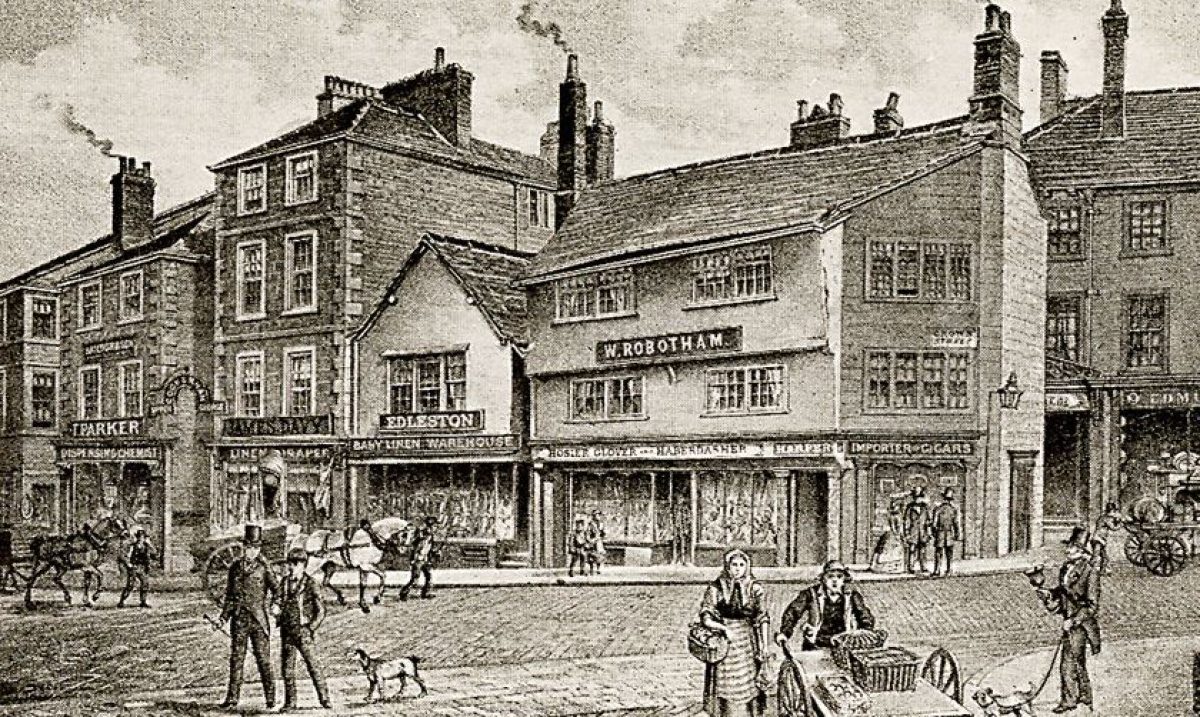We’re getting ready to record a podcast episode about the railways in Halifax, to go out later this year, and it seemed like a good time to focus in on an individual whose life was bound up in trains within Calderdale – William Akroyd, native of Todmorden, and station master at Halifax on his death.


William was born in Todmorden in 1846 to Barker and Mary (Cummins) Akroyd of Brook Street. Barker was a cordwainer, ie. a shoe and bootmaker who made new shoes and boots as opposed to someone who repaired them. Barker was from Todmorden originally and Mary from Kirby Lonsdale in Westmoreland. William was their eldest son, and he grew up in the area of Brook Street known as “Oddfellows Hall”, houses that are now demolished but were situated just below the Hall which now houses a newsagents, pharmacy and nightclub. It wouldn’t have been quite so exciting back in the day, but then again, lots of social and educational events were held at the Hall, so perhaps it contributed to his education in that sense.
The 1840s saw the establishment in Todmorden of its railway station in 1841, and the connection of the town to both Manchester and Halifax and Leeds via the Lancashire and Yorkshire Railway. The railway was a huge employer in Calderdale in the sense that labourers, navvies, and railway workers themselves all found gainful employment in the building and maintaining of its infrastructure for several decades. So rather than going into the shoe trade, it’s not surprising that William was drawn to this growing enterprise and saw a career could be had in it. When he was 15 in 1861 he was working as a cotton weaver (like most people in Todmorden), but by 1871 he had become a night watchman at the station there. One of his younger brothers, Roger, was also employed there in 1871 as a porter. Porters did everything from help passengers on and off trains with luggage to cleaning the station and working in the ticket offices. It was more of a career-advancing role than that of night watchman, but both William and Roger would advance before much longer.

By 1881 Roger had married, moved to Halifax, and become a foreman porter. William was still unmarried and living at home, and had also been promoted to railway guard. Guards were responsible for security at the station and also for ensuring that it was safe to trains to leave the platform, and that they were pulling in and braking correctly. Both roles were important, and this can be shown by a newspaper article from the Halifax Evening Courier in 1897 that gives the history of William’s employment. The census is only a snapshot of a single day; the newspapers can catch anyone at any time.

You see, William may have lived in Todmorden, but he was working everywhere. If you were willing to move around your career progression improved radically. From 1874 to 1879 William was a guard at Mirfield Station, and after that a guard at Halifax station until 1884, and until 1892 a joint inspector there too. We can find evidence that he saw the Halifax and district area as the area he wanted to stay in the most, as on the 1891 Census he was lodging at 7 Temple Street in Halifax while working as an inspector. He had finally made the move out of Todmorden, and committed to his fate.
1892 saw his biggest career advancement – promotion to station master at Brighouse. He moved to Rastrick and for the next five years oversaw the running of the station. Being a station master wasn’t just about managing the place, it was also taking ultimate responsibility for anything that happened. The railway could be a dangerous place, particularly the Lancashire and Yorkshire Railway…once described as “the most degenerate railway in the Kingdom”, there were thefts and fights galore, and often railway staff had to appear in court to bear witness to all sorts of brawls and disagreements.

1897 was a standout year for William, as he gained his possibly long-sought-after promotion to station master at Halifax and got married for the first time at the mature age of 51. The promotion came first, in July, and his marriage to Ann Greenwood of Todmorden came in October. She was 49, and it was also her first marriage. How long had they known each other? Is there a story there? Well, there is – William and Ann had three sons out of wedlock, between 1875 and 1880. Why did they wait so long? It’s a very curious arrangement for the societal standards of the time! Their marriage took place at the parish church in Rastrick, and it’s interesting to see a reminder that the levels of literacy we enjoy today weren’t always so high – Ann is unable to sign her name.

Meanwhile, Roger had also received a promotion, and had been moving around to Wakefield and Sowerby Bridge. He would eventually attain the same rank as William, but at Copley station, and despite aiming to retire shortly before WW1 he continued in the role for the duration of the war to ensure that things continued to run smoothly despite the massive disruption to their workforce and the country in general.

William’s tenure at Halifax was relatively brief, only cut short by his death in May 1905 at the age of 59. He was buried back in his hometown, and his gravestone was paid for by his apparently many friends within the Lancashire and Yorkshire Railway – fellow railway staff and even a newsagent connected with the various stations where William had worked. And as you saw at the top of the blog post, he was even well known enough for Local Studies to have been passed a photograph of him…

